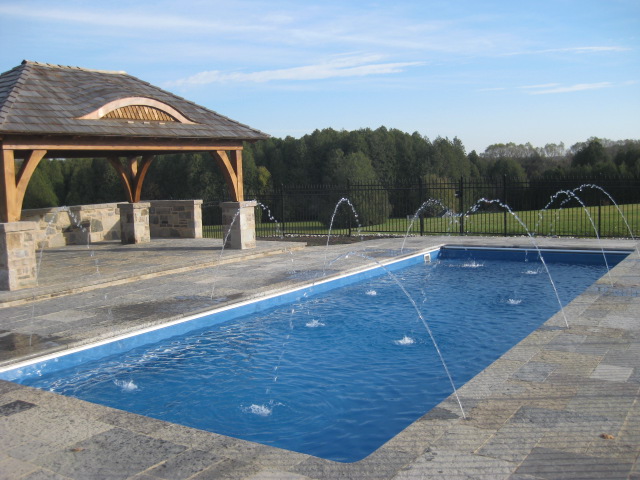This is the question that everyone asks.
“Do you install salt water pools?” After some discussion it usually becomes apparent that you’ve been talking to a friend or relative who knows someone who has a saltwater pool, and boy don’t they say it’s great! There is no maintenance required and the system does all the work for you. Wouldn’t it be nice to avoid all that work? The answer is of course yes, we COULD install a salt water system on your pool, but the question I think you need to be asking is if you SHOULD.
We have helped hundreds of customers reduce their maintenance and chlorine use, but you might be surprised to find out that our packages rarely include a salt water system. Want to know why? Keep reading….
1. Salt is not a sanitizer.
A salt water system converts salt (sodium chloride) into hypochlorous acid using an electrolytic cell plumbed into your pool system. Your pool has its own little chlorine factory right on site! You are swimming in the same chlorine as you would using pucks, liquid or powdered chlorine because all forms of chlorine form hypochlorous acid when added to water. The chlorine level in your pool, whether salt or traditional chlorine, should be 1-3 parts per million.
Then why don’t salt pools smell like chlorine? When you go to the public pool and smell the “stinky” chlorine you are actually smelling chloramines, also known as “combined chlorine” because the chlorine has “combined” with elements in the pool water as a result of destroying nasty microbes. Your own personal pool is not likely to get used as often or as heavily as a resort or hotel pool, so there are far fewer nasty microbes for the chlorine to react with. A salt water system also has the added benefit of reducing the chloramines in the water as a result of the electrolysis that creates the chlorine in the first place (it zaps the chloramines away).
2. You still need to test and balance the water.
All pools should be tested on a regular basis. Salt water chlorine generators produce byproducts that tend to cause the pH to rise and are prone to overproducing chlorine, so the pool water should be tested weekly. You can’t see or smell high pH, but left unchecked it will cause some serious problems for you, both short and long term. Most notably, water that is not properly balanced will be the number one cause of irritated eyes and skin, as well as equipment failure.
The good new is that testing your pool water and adding pH reducer or adjusting the chlorine production only take a few minutes of your time once per week.
3. Salt systems are expensive to operate.
Salt systems on an average in ground pool cost between $1500-$2000 to initially install. The cell that produces the chlorine will wear out and need to be replaced every 3-5 years and costs about $1,000 installed. That adds up to an annual cost somewhere around $300 for the first 10 years (assuming each cell lasts 5 years). This is not including salt ($20-$50 per year) or pH reducer ($40 per pail) or the cost to clean the cell every 3 months ($15 per cleaning). Most people still add other chemicals periodically, such as shock, clarifier, stabilizer and scale preventer. That means for most people it is MORE expensive to operate a salt pool.
There is another factor that you might not have considered, which is the corrosive nature of salt. A salt pool acts like a giant battery, and all the metals exposed to the water are more susceptible to corrosion because of the current running between them – including that expensive salt generator and heater you just installed. Using anti-electrolysis anodes in a salt pool is highly recommended to protect metal components from galvanic corrosion. Anti-electrolysis anodes are small discs or bars made of zinc and are attached to things like handrails, ladders and skimmer baskets because the zinc will give up its ions faster than other metals (like copper and stainless steel), so it will corrode before anything else does. Anodes should be replaced about every three year and cost in the $25-$150 range depending on how many you need to install.
4. There are affordable alternatives available.
We have installed many ozone and UV systems over the years as they help reduce your chlorine requirements and prevent those nasty chloramines that smell bad and cause irritation. Most of our new pool installations include an ozone system because they are low cost and low maintenance – fiberglass pools are already very easy to care for and ozone helps to prevent common issues like cloudy water and algae blooms. Ozone systems are less than half the cost of salt, don’t require expensive replacement parts, wont effect the pH levels of the water, and aren’t relying on chlorine alone to keep your pool clean. With ozone or UV you can maintain a lower chlorine level than using a salt systems or pucks, ideally somewhere between 0.5 to 1 ppm. Ozone and UV systems are commonly used to purify drinking water because they can kill a wider range of bacteria and viruses than chlorine alone, so using one on your pool means you are swimming in the purest water possible.
Overall, we know that many people still praise the benefits of their salt pools, but having seen the alternatives we think there are better systems out there for our customers. We want you to have the easiest pool to maintain – if our customers are happy and enjoying their pools, then we are also left with more time to enjoy our own pools!




